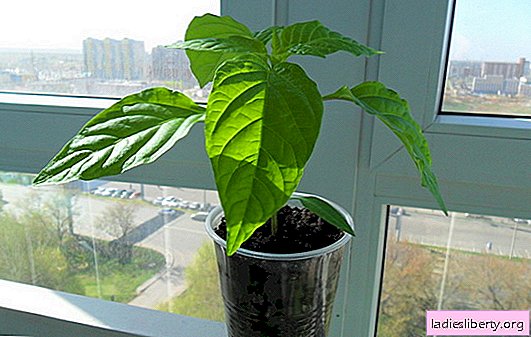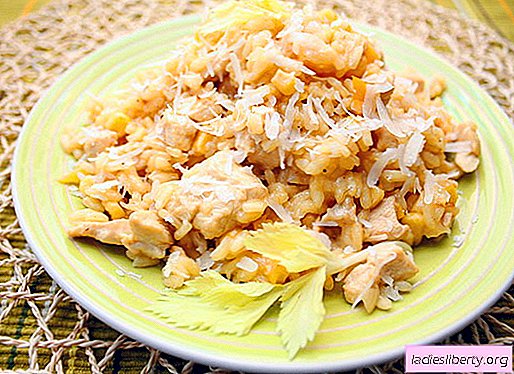
Pepper is a storehouse of vitamins in its beneficial properties.
And, of course, we would like to grow it with our own hands.
But various doubts and fears do not allow enjoying this process.
Do not be afraid!
Your efforts when growing pepper seedlings at home and observing all the necessary conditions associated with planting, watering, top dressing will pay off with a rich, fragrant and healthy crop.
Growing pepper seedlings at home: the choice of variety and seeds
At the initial stage, the most important point is the choice of pepper and seed varieties.
It could be:
1) to taste: sweet (Kolobok, Roman, Viking) and bitter (Adzhika, Twinkle, Superchili, Dragon's tongue);
2) by color: green (Beladonna, Flying), yellow (Yellow bell, Raja, Lemon miracle), orange (Orange miracle), red (Red shovel, Cowskin ear, Corvette), purple (Big dad, Sweet chocolate);
3) by maturity:
- early ripening (ripening up to 90 days): Apricot favorite, Orange king, Golden Taurus;
- mid-ripening (ripening period 90 - 130 days): Agapovsky, Atlant, Bugay, Bogatyr, California miracle, Tenderness, Hercules, Arsenal;
- late ripening (more than 130 days): Paris, Ruby, Black Cardinal, Aristotle.
4) for stuffing (Gippsi F1, Little Red Riding Hood, White-eye) or conservation (Gift of Moldova, Gold-maned lion).

Types of pepper
We want to note right away that the agrotechnical necessary conditions for growing sweet pepper seedlings at home are no different from hot peppers.
It is believed that the seeds germinate best when harvested with your own hands from your own pepper. But this rule does not always work. To date, the pepper seed market has a fairly wide range of different species that can satisfy any request. Choose brands from trusted manufacturers, check the expiration date, pay attention to the appearance (the seeds should not have a rotten smell or the smell of mold), remove the damaged seeds, make all the necessary conditions for a successful planting.
Growing pepper seedlings at home: when and how to sow (timing, top dressing, shelter, temperature, soil, etc.)
Pepper refers to those types of vegetable crops that it is desirable to grow seedlings instead of planting in open ground. The advantages of this method are undeniable, for example:
• the percentage of seed germination is increased several times, as they provide all the necessary favorable conditions;
• it becomes possible to grow valuable species and varieties of pepper in areas with a not very favorable climate;
• the result can be an earlier harvest;
• a positive economic component, since planting operations are reduced during this planting process (smaller area, less water for irrigation, less need to thin out the beds);
• when planting seedlings in open ground, you will immediately give your beds the desired decorative look and will support it.
So, you are in a moral mood, stocked with determination and decided to grow pepper seedlings at home. Where to begin? To get started, carry out such necessary conditions as seed disinfection. It can be done in a solution of potassium permanganate (30 minutes), or in a solution of peroxide (3 ml per 100 g of water heated to 40 ° C). This is necessary in order to disinfect and prevent seeds from diseases or various infections.
Also before sowing check seed germination. This procedure does not differ in complexity, but it saves you the risk of planting empty, infertile seeds. To do this, put a piece of light cloth or paper on an ordinary plate and sprinkle seeds. Then cover everything with the same wet cloth or paper and put in a warm place (+ 20 ° C) for about 7-14 days. Keep your seeds moist at all times. Further, depending on whether the seeds have sprouted or not, divide them into suitable or not for use.
Further, one of the quality tips is to keep the seeds in the refrigerator for 12 hours in order to so that they are tempered. After all, natural conditions can sometimes be so unpredictable.
Not the last role in the successful cultivation of pepper at home, and often even a necessary condition, is soil composition. Ideally, you can buy it ready. But if extra expenses are not provided for in your budget, then you can prepare such a composition yourself.
For this you will need:
- turf land (you can take a simple garden);
- humus (only not fresh, but must have lain for several years. Otherwise, you will burn all the plants);
- sand (it will improve the structure of the soil).
For pepper, the ratio of the above types of soil should be 1: 2: 1.
You can grow seedlings:
- in special plastic cups (so-called multicassettes), which are sold together with a pallet and a transparent lid for the greenhouse effect;
- in peat-humus pots or in pots, which, due to their composition, are completely decomposed in the ground. In this case, seedlings are planted together with a pot, excluding damage to its roots. However, experienced gardeners do not recommend their use, since with this method there is a delay in plant development;
- in the simplest plastic, cardboard cups, or just in the ground, wrapped in polyethylene;
- in special peat blocks, which have recently gained more and more popularity due to simplicity and ease of use.
1-3 seeds of seed are sown on one pot, removing further weak shoots. Do not forget to sign the varieties you use in order to choose your favorite in the future.
To create high humidity, the necessary conditions are created that will accelerate the germination process, the sowing devices are covered with glass, film or a plastic transparent cover.
When growing pepper seedlings at home, it is very important to observe such necessary conditions as an integrated regime of light, watering, temperature and top dressing.
If there is not enough light in the room, then use additional lighting with the help of lamps or move the boxes with seedlings to a more lighted place.
Watering seedlings does not require special conditions. It is important to prevent drying out of the soil. The first 3 days do not water, but simply moisten the soil with a sprayer. It is advisable to further irrigate with warm water. In general, pepper shoots cut through, on average, after 9 days.

Pepper seedlings one week after germination
And here it is important to prevent drying of the soil. You can also use irrigation from mineral fertilizers (for this you need to take 3 grams per 2 liters of potassium, nitrogen and phosphorus fertilizer water). A week before planting, moderate the amount of watering, because excess moisture will cause the structure of the fabric to be more loose.
Soil temperature before planting should be warmed up to 25ºС.
Seedlings are planted in the ground at the age of 2-2.5 months. A prerequisite before planting seedlings in the ground is that it must be periodically taken outside for several days. In greenhouses, it is necessary to open the frames or remove the film for a certain period of time. This is the effect of hardening the plant.
Pepper seedlings for open ground begin to be prepared from the beginning of March (some varieties can already be sown at the end of February).
Growing pepper seedlings at home: transplants, top dressing
Pepper refers to the vegetable crop that requires transplanting (picking). It is carried out with an uneven distribution of seedlings over the area of sowing. Its meaning is to remove weak small shoots that can be drawn from larger beneficial substances and trace elements. A pick is carried out when 1-2 leaves appear on the sprout. It is recommended that watering be carried out a day before the proposed process. So you more carefully carry out the transplant process and do not damage the roots of the seedlings. The rest is simple. Select healthy, well-developed seedlings and, removing a small amount of the root system, transplant using a small stick. Firmly press the resulting sprout to the ground. Do not worry if on the first day the seedlings will have a sticky appearance. This is an adaptation process. Use strip watering seedlings during this period.
As for landing in the ground. This is the last stage in which you should not ruin the whole process of growing pepper seedlings carried out before that at home. To land, choose a quiet, calm, cloudy day (if the day is sunny, then land after lunch). The air temperature should warm up to + 17ºС. The site you have by this time should be prepared. Pour seedlings abundantly (the first buds should be tied on it), separate the peat blocks, remove the seedlings from the cups (this can be done without violating the integrity of the material). Wells should be at a distance of 0.5 m from each other and 0.6 m between the rows.
The depth should be such that the root system is underground and the neck of the root is at the level of the soil surface. Immediately prepare the material for shelter of pepper seedlings, which is a necessary condition for possible frosts. It can be polyethylene, plastic bottles with cut off necks or paper caps.
Pepper feeding is recommended several times..
Two weeks and a month after the first dive. It is convenient to use the finished liquid (1 tsp per 1 liter of water): Lux, Mortar, Agricola, Fortified. Such top dressing will enhance the development of seedlings and strengthen the root system. The following top dressing is done with a solution of 1 tsp "Barrier" per 1 liter of water.
When planting in pots after a dive, 1 tablespoon can be added to the soil. double superphosphate, 0.5 tbsp. wood ash and 3 tablespoons top dressing for peppers "Signor tomato".
The main problems in growing pepper seedlings
1) Do not neglect the preliminary disinfection and hardening of seeds. Guaranteed positive result will pay off your efforts.
2) Prepare the soil mixture correctly. Do not take garden soil from places where vegetables and flowers grew. Humus use 3-4 years ago.
3) Inadequate lighting. In this case, the sprouts have an elongated shape with a disproportionately developed structure. Keep in mind that pepper is a plant that prefers short daylight hours.
4) Counting the timing of sowing seeds occurs, depending on when you plant pepper in the ground. And here it is important to prevent overgrowth of seedlings.
5) Inadequate watering. This reason can lead to the death of the plant.
6) Improper picking - violations of the root system, which leads to wilting of plants. Tip: sow pepper seeds immediately in individual devices, making the so-called the notch of the plant. Those. remove the entire lump of earth from the container and put it in the hole without violating the root system.
7) If the seeds collected by you yourself did not sprout, then you may have violated the storage rules or the original rules for collecting seeds.
8) Carefully monitor the possible pests of peppers: aphids, ticks, scoops. It is better, of course, to process seedlings in a timely manner. For this, special chemicals are suitable.
9) Use top dressing correctly and in moderate doses.
Growing pepper seedlings at home is an interesting process that in the future will provide you with a healthy harvest throughout the year. And you will be proud of yourself!











